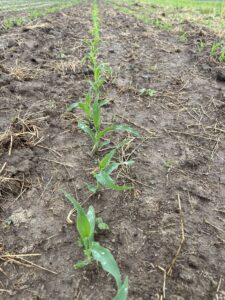Illinois Crop Update – June 6, 2025
Kathryn Seebruck – Commercial Agriculture Educator
Winnebago County
Soil Conditions: Mildly Wet (soil is wetter than normal, local vegetation is healthy)
Tuesday’s storms and Wednesday’s rain resulted in over an inch of rain being supplied to the area, which have helped to supply some needed soil moisture.
The fields referenced in today’s report have experienced some hail damage, though the plants will fortunately grow out of it as the damage was not too severe and there is enough healthy tissue to enable the plant to overcome the damage. Producers in the area are encouraged to scout for hail damage.
The soybeans in this field also seem to be exhibiting some Group 15 herbicide damage, as evidenced by the “drawstring” effect on the leaves whereby the midvein is shortened and the leaf tip is crinkled, resulting in heart-shaped leaflets. The damage is likely due to cold conditions, and fortunately, soybeans grow out of this injury quickly. Although this field is exhibiting some damage and injury, the soybeans have already produced active nodules, which may have been helped along by the producer’s use of in-furrow fertilization.
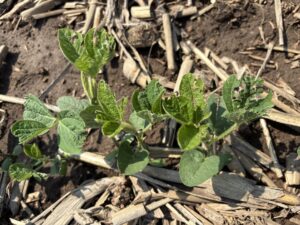
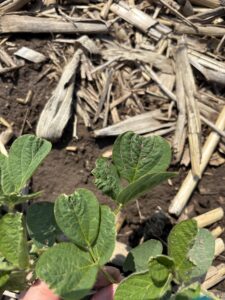
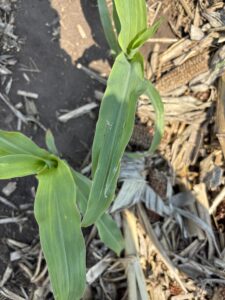
Steve Brand – Commercial Agriculture Specialist
DeKalb County
Soil Conditions: Mildly Wet (soil is wetter than normal, local vegetation is healthy)
Thank you to everyone for doing your best rain dances! June started off with 1.1 inches of much needed rain as we are still in a D1 drought in northern IL with some areas in the Freeport area reaching D2. As of Wednesday, nearly all of Northern IL received some moisture, with many areas averaging around 1 inch of rain. Plants around the region have emerged and are progressing through early vegetative states. Plants overall are a bit stunted from the lack of moisture but should shoot up after the rain and with more rain in the forecast.
Corn: The crop is progressing along. Every field I saw has emerged with most fields ranging between V2 and V4 pushing V5 depending on planting date. Corn looks healthy and green with no disease seen yet.
Soybeans: Soybeans are anywhere between V1 and V3 and emerging uniformly across the region. They are healthy and green, with some areas seeing herbicide drift damage, but the plants will grow out of this quickly.
Wheat: The crop is well on its way into Feekes 11 (ripening) or is in the very late stages of Feekes 10.5.3 (full anthesis). I have not seen much if any disease this season thus far with the continued dry weather. With the large rain on Wednesday and more predicted early next week, disease may start to creep in with various head blights. Scouting will be your best defense of knowing what is in the field.
Overall, the season is moving along quickly, and we should be seeing some great growth over the next couple of weeks
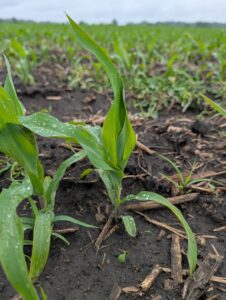

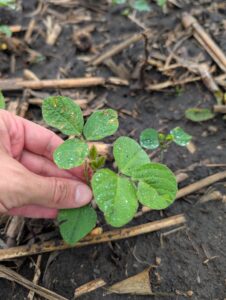
Emily Hansen – Commercial Agriculture Educator
LaSalle County
Soil Conditions: Mildly Wet (soil is wetter than normal, local vegetation is healthy)
Nearly all fields in LaSalle County have now been planted and have emerged. Areas of LaSalle County saw upwards of 5 inches of rainfall on Wednesday, so most fields are looking healthy. Corn at the Extension Research and Demonstration Plots at Illinois Valley Community College is at V4; soy is at VC-V1. Earlier planted corn in LaSalle County is nearing V7. Most soy isn’t quite as far along – the most mature I observed was at V2.
Russ Higgins – Commercial Agriculture Educator
Grundy County
Soil Conditions: Near Normal
A cool week ending with several warm days with consistent winds provided favorable first cutting hay-making weather. June 4th brought widespread precipitation across almost all of NE Illinois. Below average temperatures slowed crop growth, most apparent on no-till soy fields. Recent changes in weather patterns and welcome precipitation should accelerate growth. The regional soy crop ranges from emerging to V3. The majority of corn is V4 to V7. Yellowish corn that has yet to receive intended sidedress nitrogen is apparent. Why is nitrogen deficient corn yellow? The short answer is that nitrogen, including many other important processes, is required to produce chlorophyll used in photosynthesis; its chlorophyll that gives the corn its green color. The general consensus is to sidedress nitrogen before the corn reaches the period of rapid nitrogen uptake (V7-8 through pollination). In Nitrogen Management for Corn, Dr. Emerson Nafziger shared that applying N as late as tasseling in severely N-deficient fields may increase yields, but the later the application, the more yield will be lost. Post corn herbicide applications have started when weather (including wind) has allowed. Producers are encouraged to evaluate both pre and post herbicide applications.
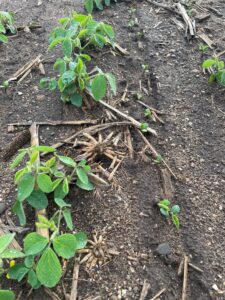
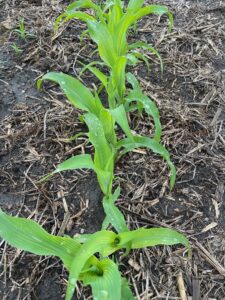

Reagan Tibbs – Commercial Agriculture Educator
Logan County
Soil Conditions: Moderately Wet (soil is damp, standing water may be present in low areas, water bodies are full)
This last week has seen very favorable conditions for crop growth across the area. The increase in temperatures has helped recently planted fields begin to emerge. Much-needed rainfall arrived yesterday (6/4), filling many low-lying areas and ditches with water. Much of the corn and soybeans across the region are in the V3-V5 stages, with favorable conditions ahead likely to support plant growth.
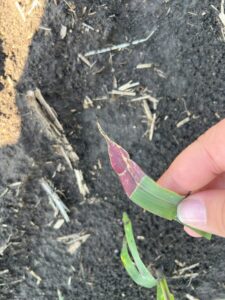
Nick Seiter – Extension Field Crops Entomologist
Champaign County
Soil Conditions: Mildly Wet (soil is wetter than normal, local vegetation is healthy)
Corn rootworm egg hatch is underway in central Illinois and will reach its peak in historical problem regions in northern Illinois over the next couple of weeks. I have not received dramatic reports of seedling insect injury so far this year – once corn is past roughly V5 and soybean gets a few true leaves on it, plants will mostly outgrow this sort of injury. Both crops are pretty resilient to early insect feeding as long as stand is not reduced.
We will participate in a regional monitoring program for corn rootworm adults again this year, beginning in early-mid July. If you are interested in participating, email me at nseiter@illinois.edu and we will send you traps and a protocol.
Talon Becker – Commercial Agriculture Specialist
Champaign County
Soil Conditions: Mildly Wet (soil is wetter than normal, local vegetation is healthy)
At the time of my survey (6/3) in northern Champaign County, soil moisture conditions were near normal in the top several inches, although some wet corners and low areas of fields could still be found. But with about an inch of rain falling on Wednesday (6/4), soils are currently a little on the wet side. Overall, the corn and soybean crops are looking healthy in the area with corn growth in a few earlier planted fields starting to take off. The average growth stage of corn fields encountered during my survey was around V3-V4 with some fields reaching V6-V7. Side-dress ammonia was being applied in a few corn fields in the area, as well. Soybeans were largely in the VC-V1 range, with a few fields a bit further along. Weed control looked good, for the most part, and post-emergence herbicide applications had been made in many of the soybean fields visited. Wheat fields surveyed were finished flowering (Feekes 10.5.4) but developing kernels are still in the “watery ripe” stage.
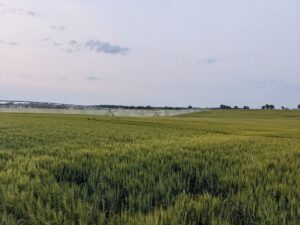
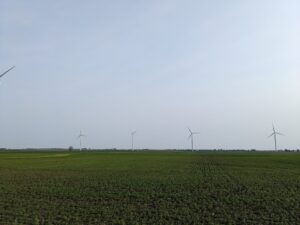
Dane Hunter – Commercial Agricultural Specialist
Marion County
Soil Conditions: Moderately Wet (soil is damp, standing water may be present in low areas, water bodies are full)
Over the last 2-3 weeks there has finally been a lot of field activity as we’ve been mostly dry with just a few sporadic showers to temper the pace. Other than a couple outlier fields, the most advanced corn is V3/V4; the average corn for the area is VE/V1, with a number of fields in the ground but not up yet. I’d say corn planting is around 90-95% complete. There might be a few fields yet to get in, but it seems like most of the corn is in the ground in Marion County.
First crop soybeans on the other hand still have a way to go, I’d guess around 2/3 of them have been planted. Other than a few outlier fields at V3, the average soybean in the area is just emerging this week if it’s in the ground at all.
Given the warm weather over the last week, wheat has turned the corner and is fully marching toward senescence. An hour south of here, in Franklin County, wheat is turning more yellow than green, and the kernels are becoming doughy. Here in Marion County the heads are still mostly greenish but yellowing fast. Depending on the weather, we are still at least 10-14 days out from wheat harvest.
